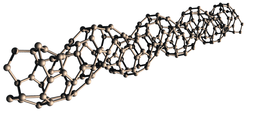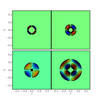Elasticity

Elastic matter is a mathematical description of solid matter such as rubber, steel, or a neutron star crust. Like fluid mechanics, it is a continuum theory which assigns a density, velocity, and (for example) internal energy density to each point in space.
However, in addition to fluid mechanics, there is a also a memory of an unstressed state at each point in space. The internal energy is lowest in this unstressed state, and so there is an elastic force that wants to return the matter to this state.
Fluid mechanics can be seen as a limit of elastic matter where there is no memory and where the stress tensor is the unit tensor times the pressure.
For queries about this topic, contact Carsten Gundlach.
View the calendar of events relating to this topic.
Projects

Fluid Structure Interactions of Yacht Sails
Stephen Turnock (Investigator), Daniele Trimarchi
The research is the main subject of the PhD topic. It regards the application of fluid structure interaction techniques to the domain of yacht sails simulation

High-resolution shock-capturing (HRSC) methods for elastic matter in general relativity
Carsten Gundlach, Ian Hawke, Stephanie Erickson (Investigators)
We are designing HRSC methods for numerical simulation of elastic matter coupled to general relativity and later magnetic fields, with the ultimate aim of simulating old neutron stars, which have elastic crusts.

How far can we stretch the MARTINI?
Syma Khalid (Investigator), Ric Gillams
To date, coarse-grained lipid models have generally been parameterised to ensure the correct prediction of structural properties of membranes, such as the area per lipid and the bilayer thickness. The work described here explores the extent to which coarse-grained models are able to predict correctly bulk properties of lipids (phase behaviour) as well as the mechanical properties, such as lateral pressure profiles and stored elastic stress in bilayers. Such an evaluation is crucial for understanding the predictive capabilities of coarse-grained models.
Imaging ultrasonic Lamb wave patterns
Visualizing ultrasonic Lam wave patterns using deflectometry and comparison with multiphysics FE results.

Life assessment methods for industrial steam turbine blade to disc interfaces
Katherine Soady (Investigator)
This is an EngD project sponsored by E.ON New Build and Technology Ltd. which aims to develop the methods currently implemented in life assessment of industrial steam turbine blade to disc interfaces to take account of the surface treatment process (shot peening) which is applied to component before service and after repair.

Microstructural modeling of skin mechanics
Georges Limbert (Investigator), Emanuele Zappia
Microstructural modeling of skin mechanics to gain a mechanistic insight into the biomechanics of the skin.
People
 Carsten Gundlach
Carsten GundlachProfessor, Mathematics (FSHS)
 Stephen Turnock
Stephen TurnockProfessor, Engineering Sciences (FEE)
 Ian Hawke
Ian HawkeLecturer, Mathematics (FSHS)
 Georges Limbert
Georges LimbertLecturer, Engineering Sciences (FEE)
 Syma Khalid
Syma KhalidPrincipal Research Fellow, Chemistry (FNES)
 Petros Bogiatzis
Petros BogiatzisResearch Fellow, Ocean & Earth Science (FNES)
 Ugur Mart
Ugur MartResearch Fellow, Engineering Sciences (FEE)
 Enrique Cuan-Urquizo
Enrique Cuan-UrquizoPostgraduate Research Student, Engineering Sciences (FEE)
 Stephanie Erickson
Stephanie EricksonPostgraduate Research Student, Mathematics (FSHS)
 Ric Gillams
Ric GillamsPostgraduate Research Student, Chemistry (FNES)
 Nicholas McCaw
Nicholas McCawPostgraduate Research Student, Engineering Sciences (FEE)
 Hossam Ragheb
Hossam RaghebPostgraduate Research Student, Engineering Sciences (FEE)
 Katherine Soady
Katherine SoadyPostgraduate Research Student, Engineering Sciences (FEE)
 Daniele Trimarchi
Daniele TrimarchiPostgraduate Research Student, Engineering Sciences (FEE)
 Emanuele Zappia
Emanuele ZappiaPostgraduate Research Student, Engineering Sciences (FEE)
 Petrina Butler
Petrina ButlerAdministrative Staff, Research and Innovation Services
 John Muddle
John MuddleAlumnus, Mathematics (FSHS)